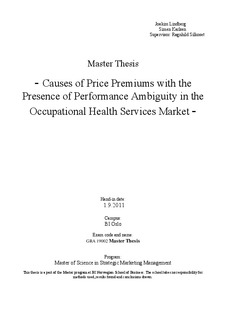| dc.description.abstract | Managers and academics have historically paid little attention to pricing. To set the right price is the fastest and most effective way for a company to maximize profits. Therefore, it is surprising that it has received limited interest. The main focus of our study is to examine suppliers’ ability to gain price premiums through factors that influence performance ambiguity and branding investments. We apply a business-to-business context in the Norwegian Occupational Health Services (OHS) market. This market is characterized by services that are hard to evaluate, due to intangible properties. Consequently, buyers have problems distinguishing between high-quality providers and low-quality providers. This is labeled as performance ambiguity. In the study, we address two types of OHS units: companies that offer OHS service themselves (make) and companies that purchase OHS services from other units (buy). We use the terms internal OHS units (make) and external OHS units (buy) throughout the thesis. We develop a conceptual model that we empirically test, with a sample of 161 OHS units in a quantitative setting. The results from our study show that buyers exist that are willing to pay a price premium to overcome the problems of performance ambiguity. Furthermore, our findings indicate that switching costs and environmental uncertainty have a significant effect on reducing performance ambiguity, and thereby contribute to sellers’ ability to charge price premiums. Contrary to our expectations, brand investments do not have an indirect effect on price premium through brand credibility. Furthermore, signaling brand credibility does not have a significant effect on sellers’ propensity to gain price premiums. A possible explanation is that OHS units spend limited resources on marketing efforts. For internal OHS units only environmental uncertainty has an effect on reducing performance ambiguity. This may be due to a lack of perceived competition, and the organization structure in itself. | no_NO |
